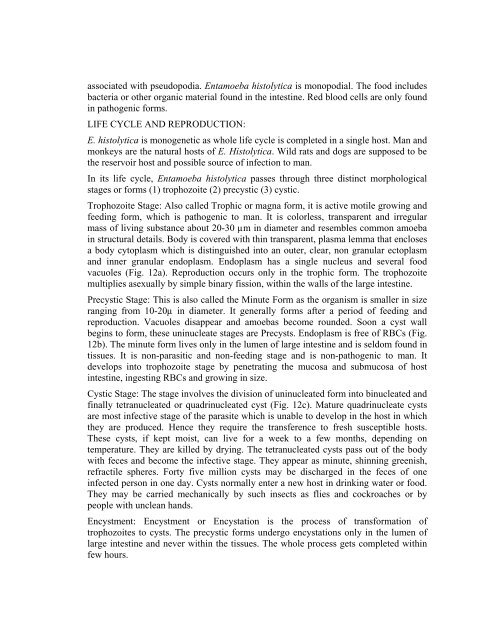ANIMAL DIVERSITY – I (NON-CHORDATES)
ANIMAL DIVERSITY – I (NON-CHORDATES)
ANIMAL DIVERSITY – I (NON-CHORDATES)
Create successful ePaper yourself
Turn your PDF publications into a flip-book with our unique Google optimized e-Paper software.
associated with pseudopodia. Entamoeba histolytica is monopodial. The food includes<br />
bacteria or other organic material found in the intestine. Red blood cells are only found<br />
in pathogenic forms.<br />
LIFE CYCLE AND REPRODUCTION:<br />
E. histolytica is monogenetic as whole life cycle is completed in a single host. Man and<br />
monkeys are the natural hosts of E. Histolytica. Wild rats and dogs are supposed to be<br />
the reservoir host and possible source of infection to man.<br />
In its life cycle, Entamoeba histolytica passes through three distinct morphological<br />
stages or forms (1) trophozoite (2) precystic (3) cystic.<br />
Trophozoite Stage: Also called Trophic or magna form, it is active motile growing and<br />
feeding form, which is pathogenic to man. It is colorless, transparent and irregular<br />
mass of living substance about 20-30 µm in diameter and resembles common amoeba<br />
in structural details. Body is covered with thin transparent, plasma lemma that encloses<br />
a body cytoplasm which is distinguished into an outer, clear, non granular ectoplasm<br />
and inner granular endoplasm. Endoplasm has a single nucleus and several food<br />
vacuoles (Fig. 12a). Reproduction occurs only in the trophic form. The trophozoite<br />
multiplies asexually by simple binary fission, within the walls of the large intestine.<br />
Precystic Stage: This is also called the Minute Form as the organism is smaller in size<br />
ranging from 10-20µ in diameter. It generally forms after a period of feeding and<br />
reproduction. Vacuoles disappear and amoebas become rounded. Soon a cyst wall<br />
begins to form, these uninucleate stages are Precysts. Endoplasm is free of RBCs (Fig.<br />
12b). The minute form lives only in the lumen of large intestine and is seldom found in<br />
tissues. It is non-parasitic and non-feeding stage and is non-pathogenic to man. It<br />
develops into trophozoite stage by penetrating the mucosa and submucosa of host<br />
intestine, ingesting RBCs and growing in size.<br />
Cystic Stage: The stage involves the division of uninucleated form into binucleated and<br />
finally tetranucleated or quadrinucleated cyst (Fig. 12c). Mature quadrinucleate cysts<br />
are most infective stage of the parasite which is unable to develop in the host in which<br />
they are produced. Hence they require the transference to fresh susceptible hosts.<br />
These cysts, if kept moist, can live for a week to a few months, depending on<br />
temperature. They are killed by drying. The tetranucleated cysts pass out of the body<br />
with feces and become the infective stage. They appear as minute, shinning greenish,<br />
refractile spheres. Forty five million cysts may be discharged in the feces of one<br />
infected person in one day. Cysts normally enter a new host in drinking water or food.<br />
They may be carried mechanically by such insects as flies and cockroaches or by<br />
people with unclean hands.<br />
Encystment: Encystment or Encystation is the process of transformation of<br />
trophozoites to cysts. The precystic forms undergo encystations only in the lumen of<br />
large intestine and never within the tissues. The whole process gets completed within<br />
few hours.
















